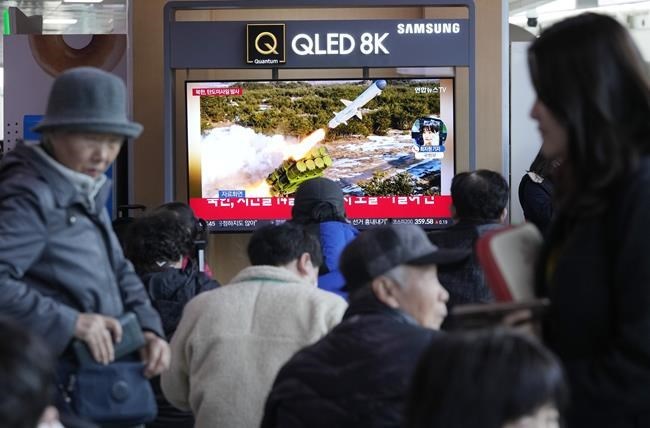SEOUL, South Korea (AP) — North Korea fired multiple short-range ballistic missiles toward its eastern waters Monday morning, its neighbors said, days after the end of the South Korean-U.S. military drills that the North views as an invasion rehearsal.
The launches were North Korea's first known missile testing activities in about a month. Outside experts earlier predicted North Korea would continue its run of missile tests and intensify its warlike rhetoric ahead of the U.S. presidential election in November to boost its leverage in future diplomacy.
Japanese Prime Minister Fumio Kishida told a parliamentary session that North Korea fired “a number of” ballistic missiles into the waters between the Korean Peninsula and Japan. He said the missiles fell outside of Japan’s exclusive economic zone and no damage or injuries has been reported.
Japan's Defense Ministry said North Korea fired three missiles, two together at 7:44 a.m. and the other about 37 minutes later. They all traveled a distance of 350 kilometers (about 220 miles) at the maximum speed of 50 kilometers (about 30 miles) per hour.
Kishida denounced North Korea’s repeated ballistic missile tests as acts “that threaten the peace and safety of Japan, the region and the international society.” He said Japan strongly protested against North Korea over its testing activities, saying they violated U.N. Security Council resolutions that ban the North from engaging in any ballistic activities.
South Korea’s military said it also detected “several” suspected short-range ballistic launches by North Korea on Monday morning. The Joint Chiefs of Staff said the South Korean military bolstered its surveillance posture and is closely coordinating with the United States and Japan.
During the South Korea-U.S. military drills that ended Thursday, North Korean leader Kim Jong Un guided a series of military training exercises involving tanks, artillery guns and paratroopers. The 11-day South Korean-U.S. drills involved a computer-simulated command post training and 48 kinds of field exercises, twice the number conducted last year.
The North didn’t perform any missile tests during its rivals’ training, however. Its missile tests are considered much bigger provocations as North Korea has been pushing hard to mount nuclear warheads on its missiles targeting the U.S. mainland and its allies. Many experts say North Korea already has nuclear-armed missiles capable of reaching all of South Korea and Japan, but it has yet to have functioning long-range missiles that can strike the U.S. mainland.
Before Monday’s launches, North Korea last carried out missile tests in mid-February by firing cruise missiles into the sea.
Animosities on the Korean Peninsula remain high in the wake of North Korea’s barrage of missile tests since 2022. Many of the tests involved nuclear-capable missiles designed to attack South Korea and the mainland U.S. The U.S. and South Korean forces have responded by expanding their training exercises.
This year, North Korea performed six rounds of missile tests before Monday’s launch.
Experts say North Korea likely believes a bigger weapons arsenal would increase its leverage in future diplomacy with the United States. They say North Korea would want to win extensive sanctions relief while maintaining its nuclear weapons.
Worries about North Korean military moves have deepened since Kim vowed in a speech in January to rewrite the constitution to eliminate the country’s long-standing goal of seeking peaceful unification of the Korean Peninsula and to cement South Korea as its “invariable principal enemy.” He said the new charter must specify North Korea would annex and subjugate the South if another war broke out.
Observers say North Korea may launch limited provocations along its tense border with South Korea. But they say the prospects for a full-scale attack by North Korea are dim as it would know its military is outmatched by the U.S. and South Korean forces.
___
Yamaguchi reported from Tokyo. Associated Press writer Yuri Kageyama in Tokyo contributed to this report.
___
Follow AP’s Asia-Pacific coverage at https://apnews.com/hub/asia-pacific
Hyung-jin Kim And Mari Yamaguchi, The Associated Press




